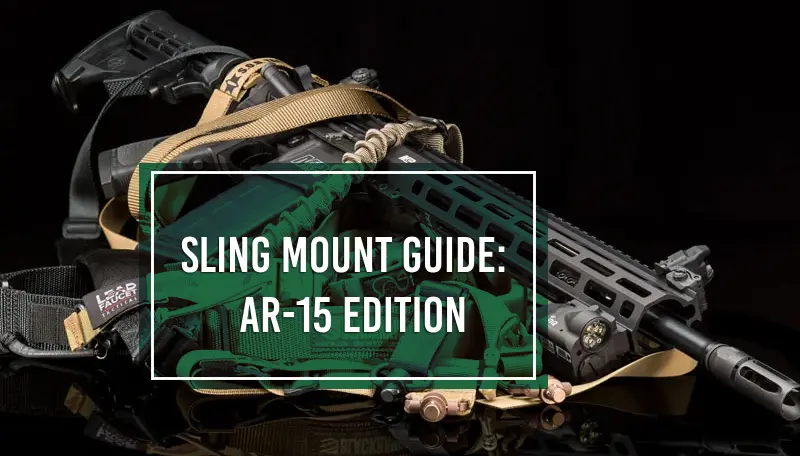
A gun sling has almost become an integral part of the iconic AR-15 image. This accessory, though pretty simple, offers utility that is too good to refuse. But rare are the cases when buying only a sling is sufficient. Being a piece of fabric or leather, a sling has a hard time attaching to a rifle. This is where a sling mount comes into play. It is thanks to them that slings can be securely mounted. Sling mounts are abundant and it might be hard to choose among all of them. In this guide, we’ll take a look at both slings and sling mounts, with a stronger focus on the latter.
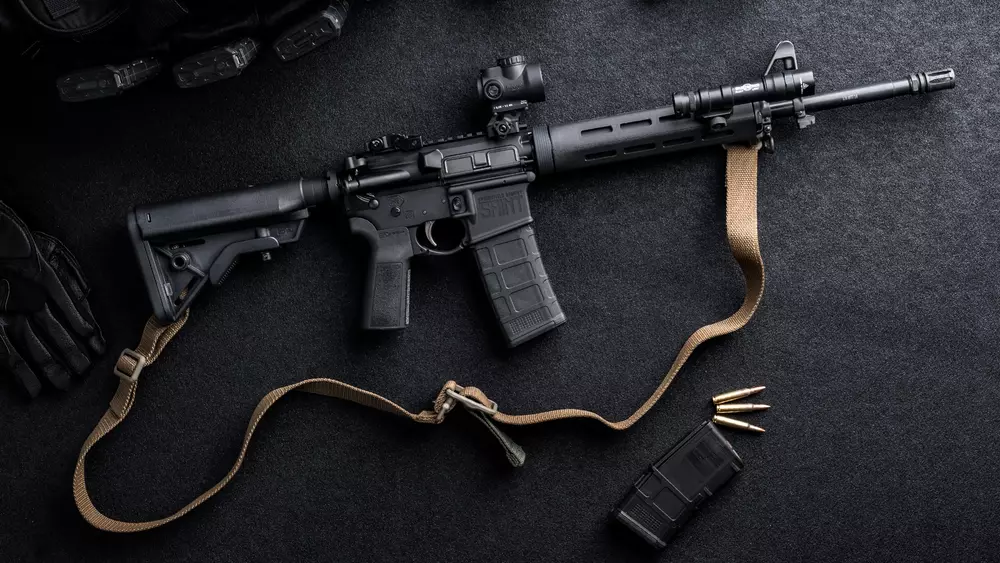
Understanding the Basics of AR-15 Slings
Before getting to sling mounts themselves, it might be useful to learn what exactly they mount. A sling is essentially the AR-15 equivalent of a guitar strap, made from durable material like nylon or leather, used to carry and handle the rifle. It secures the firearm to your body, allowing you to move freely while keeping your hands available for other tasks. A true asset in tactical situations and a pleasant accessory during other scenarios.
Now, why is a sling so important for handling an AR-15 rifle? Well, there are several reasons:
- Weapon Retention: A sling helps keep your AR-15 attached (in a way) to your body. It is indispensable if you need to use your hands for something other than holding a gun, and, to be honest, there are plenty of things you need them for. In addition to that, it won’t fall to the ground or into the wrong hands should you accidentally lose grip on it.
- Improved Mobility: With a sling, you can carry your AR-15 hands-free which helps immensely with maneuverability. This is especially useful when navigating difficult terrain or performing multi-task operations. You can climb, un, or even drive without having to put down your rifle.
- Shooting Stability: Believe it or not, a sling can actually help you shoot more accurately. You can do a trick and have a sling create tension between your body and the rifle, which will provide additional stability when aiming and shooting.
- Quick Transition: In situations where you need to switch from your AR-15 to a secondary weapon (like a sidearm), a sling enables the transition to be fast and smooth. You can simply let go of your rifle, and it will stay secured to your body while you draw your secondary weapon.
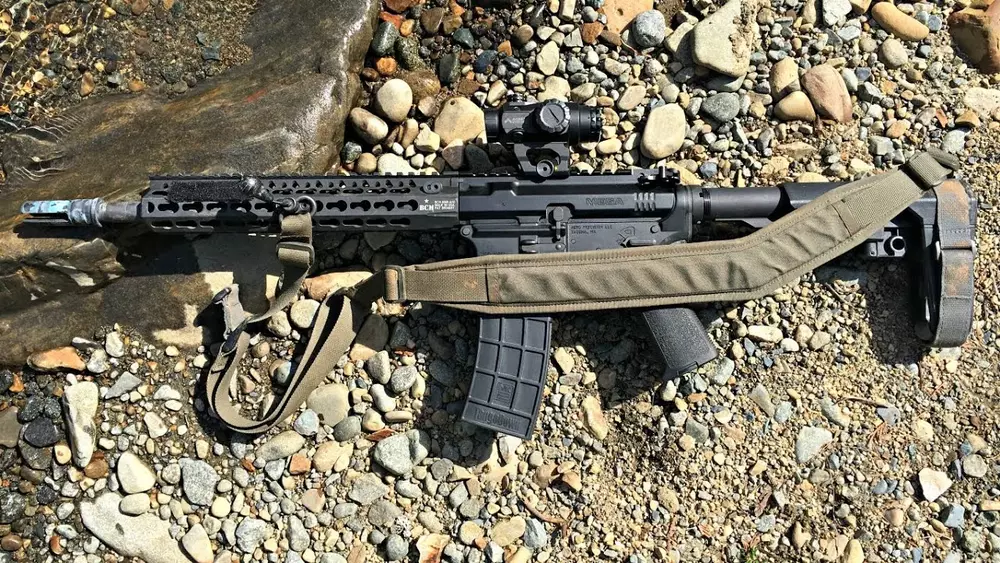
A Deeper Dive into AR-15 Slings
Now then, there are three major types of slings sold on the market. They are not fundamentally different but still boast some distinctions. To choose the most suitable type of mount, you need to know what your sling type is, as it will determine a number of defining characteristics.
One-Point Slings
One-point slings, as the name suggests, attach to your AR-15 at a single point, typically at the base of the stock or the buffer tube. The greatest advantage of these slings is their simplicity. They enable swift transitions between shooting and carrying positions, which makes them particularly suitable for close-quarters combat scenarios.
However, this mobility comes with a trade-off. Because it’s only attached at one point, the rifle will likely swing around quite a bit when you’re on the move, so some banging against your knees or other parts of the body is inevitable. That is, unless you use one hand to keep it from swaying. This lack of stability can make one-point slings less ideal for long-distance treks or situations where you need both hands free.
Two-Point Slings
Two-point slings are the most traditional type of sling that attaches to your AR-15 at two points, usually at the stock and just past the handguard. These slings offer superb stability compared to one-point slings and can even be used as a makeshift shooting aid by creating tension against your shoulder.
Two-point slings are versatile and work well for a variety of activities, from hunting to tactical use. The downside? They take more time to don and may not allow for as quick a transition between carrying and shooting positions as one-point slings.
Three-Point Slings
Three-point slings are the most complex of the bunch. They secure your AR-15 at two points, like a two-point sling, but also feature an additional loop that goes around your torso. This design offers excellent stability and keeps your rifle close to your body, even when your hands are off the weapon.
On the flip side, three-point slings have more straps and buckles, which makes it more likely to interfere with other gear you wear or even you handling your rifle. They are also more challenging to adjust and may get tangled if not used correctly.
Introduction to Sling Mounts
Slings would have been utterly useless without something that could properly fix them to a firearm. Coiling them around the upper and stock would cause them to bring more inconvenience than use. That’s where sling mounts came in. They are what keeps your AR-15 securely attached to its sling. They are the critical link that should be chosen with utmost prudence.
Sling mounts come in a variety of forms and are typically made of durable materials like steel or aluminum. They can be located in various places on your AR-15, such as at the base of the stock, on the handguard, closer to the tip of the gun or even replacing the standard end plate of the rifle.
What do they do? In short, they connect. The primary function of a sling mount is to provide a sturdy and reliable point of attachment for your sling. It’s up to the mount to ensure that the sling doesn’t detach when you’re moving around.
Sling mounts also enable you to position your rifle the way you see fit. For instance, a sling mount located towards the rear of your AR-15 lets you carry your rifle over your shoulder, while a mount towards the front allows for across-the-chest carry.
Some types of sling mounts, known as quick-detach (QD) mounts, are designed for swift and easy attachment or detachment of the sling. This can be particularly useful in situations where you need to quickly switch between carrying and shooting positions.
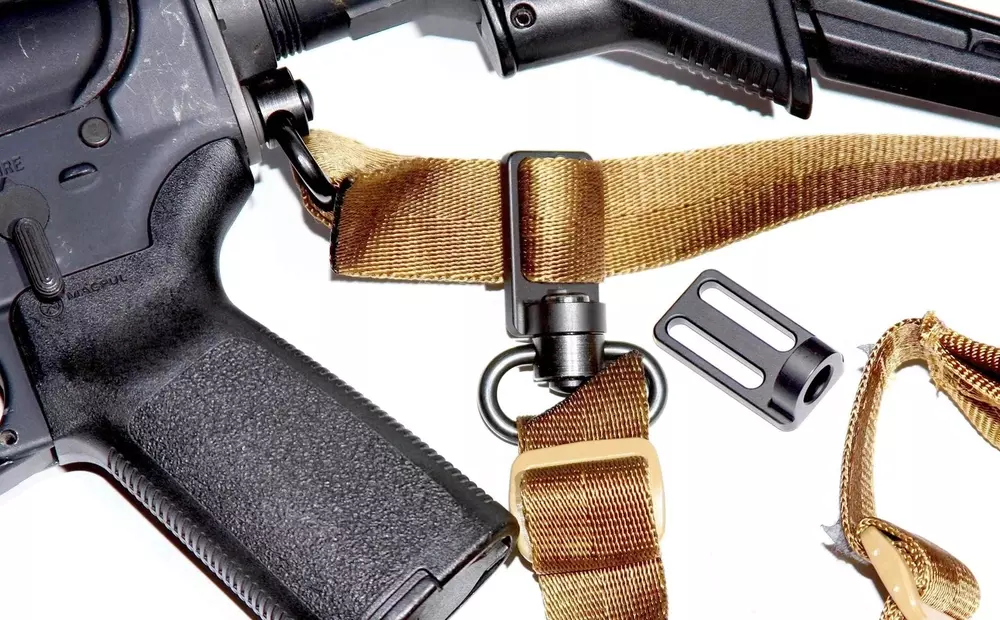
Comprehensive Guide to Sling Mount Varieties
We’ve scratched the surface of what a sling mount is, now it’s time to go for a deeper cut. There are two main types of sling mounts: quick-detach and regular mounts. The difference between the two is pretty apparent, but we’ll elaborate on both those types nonetheless.
Let’s start with quick-detach mounts. These are designed for easy attachment and detachment, as the name suggests. They usually come with a push-button design that allows you to quickly release or attach the sling. If you can imagine yourself in a situation where you need to rapidly detach your sling, this is the most suitable type.
However, quick-detach mounts do have some drawbacks. For one, they fetch a higher price than regular mounts. Additionally, like any other mechanism, the quick-release might accidentally engage if not properly maintained or handled. These potential drawbacks don’t prevent users from using them, though, for the convenience such mounts offer is too good to pass.
Moving on to regular sling mounts. These have been around for quite a while and managed to develop a variety of styles including fixed loops, swivel loops, end plate loops and clips.
Fixed loop mounts are not as much mounts as they are parts of the rifle. They provide the most secure and sturdy mounting point for your sling but lack the flexibility of other mount types. The sling can’t rotate, which might limit your movement in certain situations.
Swivel loop mounts offer more flexibility than fixed loops. Most of them allow the sling to rotate freely, but not all. They might be noisy when moving, which can hardly be an advantage.
End plate loops are another type of regular sling mount. They are typically installed at the rear of the rifle over the buffer tube or replacing the standard end plate. This type of mount is ideal for single-point slings and provides a low-profile, ambidextrous mounting point.
Lastly, we have clips. These are versatile carabiner-style hooks that can be attached to various points on your rifle. They offer a good balance between fixed and swivel loops, providing both security and flexibility. Clips are also quick and easy to remove. However, they might not be as durable or sturdy as other mount types.
Factors to Consider When Choosing a Sling Mount
A sling mount may look like a trifle, a piece of equipment that doesn’t really require much time to choose. But it should never be about picking the first one you see. There are several factors that should inform your decision so that you could make the best choice for your needs. Let’s dive into some of these factors:
Type of Sling: The first thing to consider is the type of sling you’re using. Different sling types may require different mounts. For instance, a single-point sling typically requires an end plate loop, while fixed or swivel loops would be a better fit for a two-point sling.
Material and Build Quality: The durability of your sling mount is crucial. A single failure to retain the sling could cost you a lot, depending on what situation you’ll find yourself in when that happens. Look for mounts made from high-quality materials like steel or aircraft-grade aluminum. These are sure to withstand heavy use and harsh conditions.
Ease of Installation: Some sling mounts, especially quick-detach ones, can be easily installed without the need for a gunsmith. Others might require professional assistance. If you want to do it all yourself, look for a mount that comes with clear installation instructions.
Quick-Detach vs Regular: Quick-detach mounts offer convenience and speed, but they tend to be more expensive. Regular mounts are just as reliable and usually more affordable. Decide which features are most important to you.
Flexibility and Mobility: Consider how much movement and flexibility you need. If you switch shooting hands often or move around a lot, a swivel mount might be more beneficial. If you prefer stability over flexibility, an AR-15 with a fixed loop might be a better choice.
Noise Level: Some sling mounts, especially swivel types, can produce noise when moving. This could be a factor to consider if you’re using your rifle for hunting or any activity where silence is critical.
Price: Lastly, consider your budget. While it’s important to invest in a high-quality sling mount, there’s no need to break the bank. There are plenty of affordable options available that don’t compromise on quality.
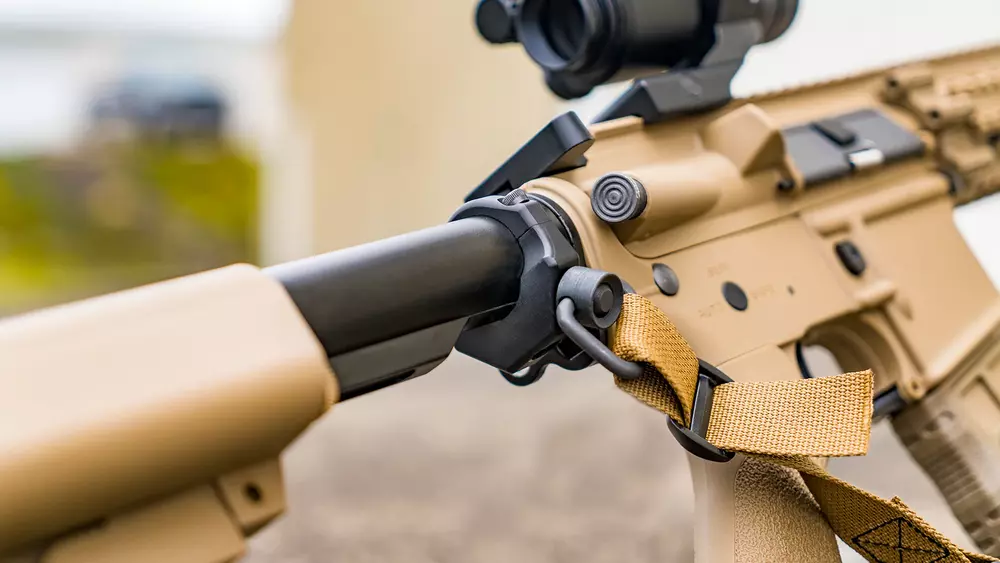
Step-by-Step Instructions on How to Mount a Sling
Whereas each type of mount would require its own instruction, it is nonetheless possible to draw up a generalized guide to mounting a sling. In addition to your rifle, sling and sling mount you might need additional mounting hardware and some tools like a wrench or a screwdriver.
Step 1: Identify Mounting Points
The process starts with you identifying where you’ll attach the sling on your rifle. For a two-point sling, you’ll need two mounting points. One is usually near the buttstock, and the other is near the handguard or barrel. The exact locations can vary depending on your preferences and the specific design of your rifle.
Step 2: Attach the Rear Mount
Start by attaching the rear mount near the buttstock. Depending on the type of mount, this could involve screwing it into place, sliding it onto a rail, or replacing the existing end plate with one that has a loop. Make sure the mount is securely fastened and oriented correctly for the sling to clip or loop onto.
Step 4: Attach the Front Mount
If it’s the two-point sling you plan to use, repeat the process with the front mount near the handguard or barrel. Again, ensure that it’s securely attached and properly oriented.
Step 5: Attach the Sling to the Mounts
Now you can attach the sling to the mounts. How you do this depends on the design of your sling and mounts. Some slings clip onto the mounts, while others loop through them. Make sure the sling is not twisted and that it hangs at a comfortable length when the rifle is slung over your shoulder.
Step 6: Adjust the Sling
Finally, adjust the sling as necessary for comfort and functionality. Most two-point slings are adjustable, allowing you to change the length of the sling depending on your needs. You might want the sling tighter for more stability while shooting, or looser for more mobility while carrying. You can always adjust it later, so it’s an optional step.
Conclusion
Having a sling mounted to your AR is a great way to increase your gun’s utility. It spares you the need to constantly carry your firearm and can even provide some minor benefits while shooting. But slings are only as good as their mounts are. Without a proper foundation, no sling will be as useful as it could. Don’t skimp on a sling mount, and you’ll get a reliable accessory that will serve you long and faithfully.
Check out our other articles on AR-15:
- 6 Best AR-15 Rifles For Your Needs
- AR-15 Scope Guide: Long & Close Range Options
- The Different Types of AR-15 Buffer Tubes, Buffers & Springs
- How to Pick the Perfect Red Dot Sight for Your AR-15 Rifle
- How to Choose an AR-15 Rifle Case – 2023
FAQs
What are the different types of sling mounts for an AR-15?
There are several types of sling mounts for an AR-15, including quick detach mounts, fixed and swivel loop mounts, end plate loops and clips.
What should I look for in terms of material and build quality when choosing a sling mount?
Look for a sling mount made from durable materials like steel or reinforced polymer. It should be sturdy and well-constructed, with no loose parts or sharp edges. The finish should resist rust and corrosion.
What’s the difference between quick-detach and regular sling mounts for an AR-15?
Quick-detach (QD) mounts allow you to easily remove or attach the sling without the need for additional tools. Regular mounts, on the other hand, typically require tools to attach or detach the sling. QD mounts provide more flexibility but may be less secure than regular mounts.




Leave a Reply